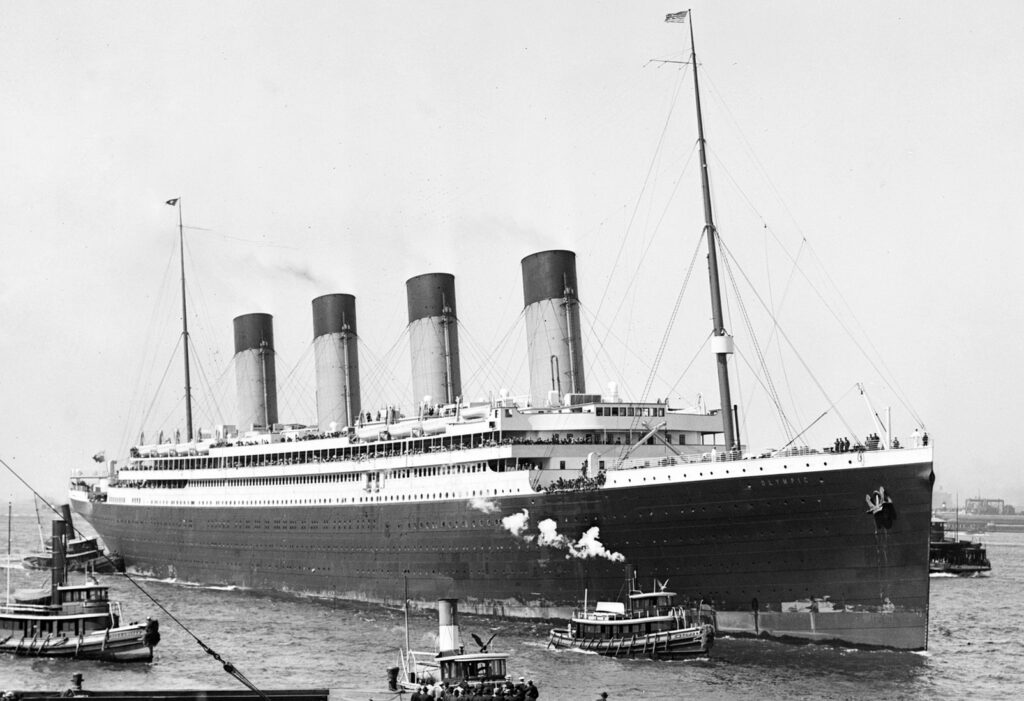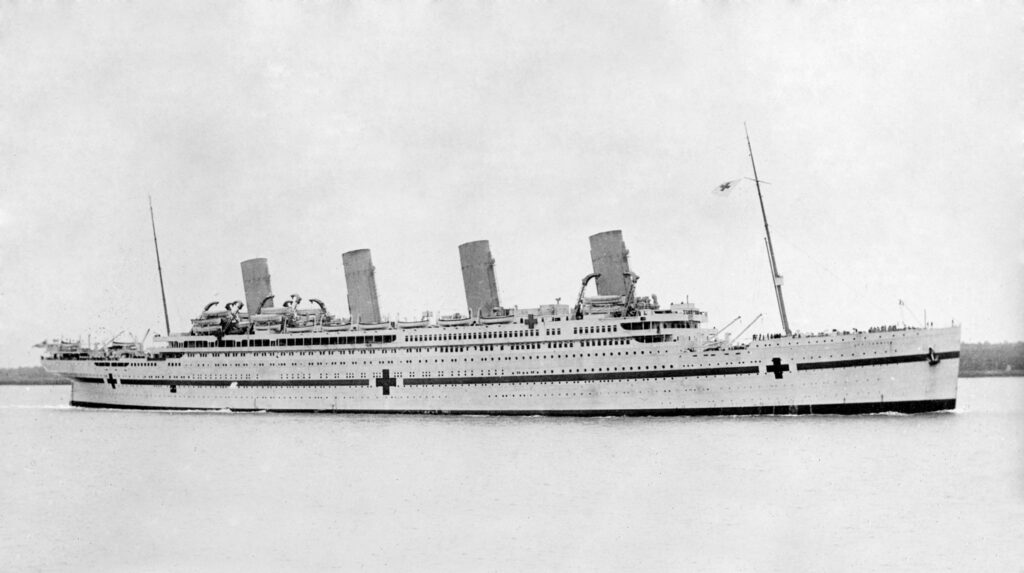If you ask someone what the most famous ship in history is, there’s a good chance that their answer will be the Titanic. The tragic darling of dozens of movies, books, and songs, the Titanic earned her notoriety when she hit an iceberg and sank during her maiden voyage. But did you know that she wasn’t the only ship of her kind?
Built alongside the Titanic were two other incredible ocean liners: the HMHS Britannic and the RMS Olympic.
Introduction to HMHS Britannic and RMS Olympic
During the late 19th and early 20th centuries, a rivalry was brewing. The trans-Atlantic cruise industry was growing by leaps and bounds, and the rush to be at the forefront of this new type of travel was ferocious.
This competition wasn’t just between countries, though. While Germany was producing a class of ships they were calling the “Kaiser class”, two British companies, the Cunard Line and the White Star Line, were competing amongst themselves.
Cunard Line had everyone else beat when it came to speed, owing to their Lusitania and Mauretania,but as far as luxury went, White Star Line knew they had the superior product: Olympic-class liners Olympic, Britannic, and Titanic.
Titanic’s story is known throughout the world, so today, we’ll be focusing on the lesser-known sisters of that fateful ship, because Olympic and Britannic have incredible stories all their own.
The RMS Olympic: The First of Three Sisters
The first of the three sister ships to be constructed was the RMS Olympic. White Star Line hired construction firm Harland and Wolff, and construction began on December 16th, 1908 in Belfast, Ireland.

Modifications were made to the shipyard where the Olympic was being built, merging multiple slips into larger ones so that the Olympic and the Titanic could be built alongside each other. Both ships were so massive that the Titanic had to be started three months after the Olympic because of the stress the two giant ships put on the shipyard. The Olympic herself was 882 ft long.
The Olympic was completed and launched on October 20th, 1910. The White Star Line had a tradition where they never christened their ships, so Olympic followed suit. They also chose to paint the liner a light gray, owing to the fact that the color photographed better in black and white.
Olympic hit the water with much fanfare, and after the filming of her launch and the subsequent pictures were taken, Olympic was repainted black. She began her career as the first of the Olympic-class ocean liners of the White Star Line in 1911.
What Made the RMS Olympic Special?
All three of the Olympic-class ocean liners garnered significant attention from the public. They were considered to be some of the most advanced ships of the time, and the most luxurious. At the time of her construction, the Olympic was the largest ship in the world. When Titanic was finished, it took that mantle from the Olympic…for a short time, at least.
There were many similarities between the Titanic and the Olympic in terms of appearance. The Titanic was larger, but both ships were equally as stunning and lavish. Of the three Olympic-class liners, Olympic herself would prove to be the luckiest.
Sea Trials and Maiden Voyage of RMS Olympic
Before she could embark on her maiden voyage, the Olympic had to complete a battery of sea trials. These tests made sure the liner was fit for her work as a cruise ship. Olympic passed her trials, and from there, was ready for her maiden voyage.
The maiden voyage set off from Southampton on June 14, 1911, bound for New York City. She arrived on June 21st. The entire endeavor, from beginning to end, attracted worldwide attention. In South Hampton, New York City, and her two ports of call, Cherbourg and Queenstown, there were huge crowds of both the media and the general public, desperate to see the new luxury liners from the White Star Line.
Two notable people aboard the Olympic during her maiden voyage were Captain Edward Smith and Designer Thomas Andrews. Both men would perish just one year later aboard the Olympic’s sister ship, the Titanic.
Career and Incidents of the RMS Olympic
Compared to her sister ships, the Olympic had a long and illustrious career. While she did see her fair share of unfortunate incidents, she never sank. Olympics career spanned nearly a quarter century–she was active for twenty-four years before being retired.
The Olympic didn’t only work as a cruise ship, either. During World War I, she served as a troopship, earning the nickname “Old Reliable”.
The notable Incidents involving the RMS Olympic are:
- The Collision with the HMS Hawke: The same year she had her maiden voyage, Olympic would collide with the warship HMS Hawke. Both ships were damaged, but neither sank, and both were repaired. This collision was a financial disaster for the White Star Line.
- Time as a Troopship in World War I: Olympic served as a troopship during the First World War for four years, 1914-1918. She was outfitted with weapons and painted with dazzle camouflage. Afterward, she would return to life as an ocean liner.
- Sinking of U-03: During her WWI service, Olympic struck and sank U-boat 103.
- Collision with Nantucket Lightship LV-117: Olympic’s only deadly accident was when she struck a lightship during an approach to New York. The hit was devastating to LV-117, which was sliced in half almost instantly by the much larger Olympic, and seven of the lightship’s crew perished.
HMHS Britannic: The Third Tragic Sister Ship
The last of the three Olympic-class ships to enter production was the HMHS Britannic. When construction began on the Britannic, the end result was planned to be incredibly similar to the Olympic and Titanic. But while it was still being built, both the Olympics’s strike of the Hawke and the Titanic’s sinking occurred, leading to changes to make the Britannic safer.

Britannic was fitted with her final funnel and launched on February 26, 1914. Due to the notoriety of the other two Olympic-class liners, there was great public interest in the Britannic.
Britannic, though, would never enter life as a cruise ship. Instead, she was destined for war.
What Made HMHS Britannic Special?
Out of all three ships, the Britannic benefitted the most from the downfalls of its sister ships. After the unbelievable tragedy of the Titanic, modifications were swiftly made to the Britannic to prevent such a thing from ever happening again.
Britannic had a double hull, and adjustments were made to the watertight chambers to help the liner stay afloat in case of flooding.
Maybe the most drastic change that the Britannic underwent was the addition of crane-like machines called davits that would be able to launch lifeboats in case of an emergency. This way, no time had to be wasted launching the lifeboats manually, and since the davits were motor-powered, the lifeboats could be launched even if the ship was listing.
Learning from the Titanic’s mistakes, the Britannic was fitted with enough lifeboats to carry 3,600 people, which was almost 300 more than the maximum capacity of the liner. 3,309.
World War I and the Maiden Voyage of HMHS Britannic
For the Britannic, there would be no maiden voyage with loads of fanfare and media attention. Instead, before she could enter service as a cruise liner, she was requisitioned as a hospital ship for the war.
Luxury staterooms were transformed into operating rooms, and the dark hull of the Brtannic was painted bright white, adorned with a startlingly red cross, and green stripe. Common areas became wards for the wounded, and suites that would have been enjoyed by vacationing families became the homes for wartime doctors.
Instead of bearing the designation RMS like her sister ships did, standing for Royal Mail Ship, Britannic’s designation was HMHS, or Her Majesty’s Hospital Ship.
Brtannic’s maiden voyage was on December 23, 1915. Her destination was Naples, where she was to pick up her first load of the wounded.
Career, Incidents, and Sinking of the HMHS Britannic
The White Star Line always hoped that the most advanced of their Olympic liners, the Britannic, would be able to begin her career as a passenger ship once her stint in the war was done. Unfortunately, it was just not meant to be.
The notable incidents involving the HMHS Britannic are:
- End of Military Service and Conversion: Britannic was dismissed from military service in June of 1916, and the British government paid the White Star Line compensation to return the ship to its previous form of an ocean liner.
- Recalled to Service: Before the conversion could be completed, the Britannic was recalled to military service in August of 1916.
- Quarantined: During her fifth voyage, the crew of the Britannic was hit by a food-borne illness, and was quarantined in Mudros.
HMHS Britannic’s Final Voyage and Sinking
Later that same year, in November 1916, The Britannic was in the Kea Channel near the Greek Isle of Kea. Thus far, the Britannic had not seen battle or faced hostilities, but that good luck was about to come to an end.
In a chilling echo of the collision Titanic had years ago with an iceberg, Britannic struck something, and a deafening explosion shook the ship.
Britannic had hit an underwater mine planted by Germany’s submarine, SM U-73. Being such a massive ship, not everyone aboard felt the explosion as intensely, and some of the crew was slower to react than others.
Britannic’s Captain Bartlett and his Chief Officer were present on the bridge when the explosion occurred, and thankfully, they recognized the severity of the situation right away. Measures were enacted to try and keep the ship afloat, while Bartlett sent out distress signals to nearby ships.
The Britannic was close to the Isle of Kea, and Bartlett tried to steer the liner towards shore in an effort to beach it and prevent sinking. This effort was for naught, though–Britannic was sinking, and fast.
It was time to see if the improved safety measures would save Britannic’s crew, or if her sinking would be the mirror image of her sister, Titanic.
Bartlett gave the order to prepare the lifeboats, and the evacuation began. Still waiting to see if he could make it to shore, Bartlett held off on letting the passengers board the lifeboats. Soon enough, though, he gave the order to cut the power to the ship and get the passengers off the Britannic.
Horrifyingly, before permission was given to lower the lifeboats, two were put into the water on the port side. The propellers were still running at this point, and both the lifeboats, as well as the passengers on board, were sucked in, instantly obliterating them.
Besides this tragic incident, the evacuation was underway. Other ships were on the way for rescue, and with the help of the davits, lifeboats were lowered into the water successfully.
There were 1,066 people on board Britannic. Even though it sank in only 55 minutes, 1,036 of those on board survived. Compared to Titanic, it was a miracle.
Legacy of RMS Olympic and HMHS Britannic
Even though their mark on history pales in comparison to Titanic, the Olympic and Britannic still changed the maritime world for good.
Olympic’s ability to survive, and even enter battle during WWI, was proof that the Olympic liners weren’t all doomed. Although Britannic sank, its successful evacuation of people on board perfectly displayed how the improvements to the ship saved hundreds of lives.
While all three ships are now gone, they gave pieces of themselves to history which will forever endure.
References
“Olympic”
https://www.britannica.com/topic/Olympic
“Olympic-class Ocean Liner”
https://en.wikipedia.org/wiki/Olympic-class_ocean_liner
“TITANIC’S SISTERS: THE LUXURIOUS OLYMPIC-CLASS OCEAN LINERS”
https://www.history.co.uk/articles/titanics-sister-ships-olympic-class-ocean-liners

